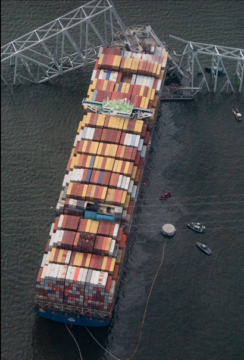by Brooks Riley
 One of nature’s most endearing parlor tricks is the ripple effect. Drop a pebble into a lake and little waves will move out in concentric circles from the point of entry. It’s fun to watch, and lovely too, delivering a tiny aesthetic punch every time we see it. It’s also the well-worn metaphor for a certain kind of cause-and-effect, in which the effect part just keeps going and going. This metaphor is a perfect fit for one of the worst allisions in US maritime history, leading to the collapse of Baltimore’s Francis Scott Key Bridge after it was hit by the container ship MV Dali on the morning of March 26, 2024.
One of nature’s most endearing parlor tricks is the ripple effect. Drop a pebble into a lake and little waves will move out in concentric circles from the point of entry. It’s fun to watch, and lovely too, delivering a tiny aesthetic punch every time we see it. It’s also the well-worn metaphor for a certain kind of cause-and-effect, in which the effect part just keeps going and going. This metaphor is a perfect fit for one of the worst allisions in US maritime history, leading to the collapse of Baltimore’s Francis Scott Key Bridge after it was hit by the container ship MV Dali on the morning of March 26, 2024.
At that hour, long before dawn, it was too dark for the resulting ripple effect to be seen. But it was most certainly a hefty version of the pebble drop, with waves fanning out all the way to the harbor berth from which the Dali had just departed. At daybreak, when images of the disaster began to appear everywhere, the ripples were no longer visible. But given the catastrophic consequences of this event, and the tragic loss of life, they were, and still are, fanning out across the globe.
Am I the only one who can’t stop looking at images of this disaster? Am I the only one who sees an awful beauty in them? Or is it a beautiful awfulness? The frenzy of angles, the implosive intensity of the damage, the jolly Lego-like containers in Bauhaus colors still neatly stacked atop the ship in defiance of the tangled metal of the bridge’s cold steel mesh structure lying over the ship’s forecastle where it fell. Add to that the murky, shifting colors of the water, lending the disaster a visual context like a fluid frame—a calming contrast to the frozen pandemonium it encircles. Read more »
